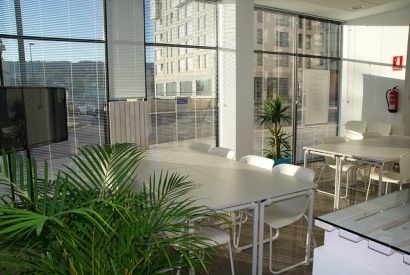
Commercial buildings consume nearly 20% of energy in the U.S. through lights, plumbing, heating and technology. Gas, electricity and water usage from these buildings add carbon emissions to the atmosphere, damaging Earth’s ozone layer and harming the planet.
While the green building industry is growing rapidly, the concept isn’t new. Throughout history, cultures have utilized natural resources to build and use homes and workplaces. The Industrial Revolution increased use of natural resources. By the 1970s, researchers noticed how using those resources impacted the environment and pushed for sustainable building practices and energy conservation.
In the 1990s, many organizations researched, developed and encouraged more sustainable building and production processes. These included the U.S. Green Building Council, the Environmental Protection Agency’s Energy Star program and the American Institute of Technology’s Committee on the Environment with the Environmental Resource Guide.
Thankfully, more industries are using green building practices and implementing sustainability. Improving their environmental impact allows leaders to notice other positive changes among employees. In greener working conditions, employees are more productive and have better physical and mental health.
Here are more known impacts of sustainable practices on employee productivity.
Sustainable buildings can help workers stay energized throughout their workday. Natural light from large windows and skylights can regulate their circadian rhythms, helping them to stay alert during the day and sleep better at night.
Office workers often have a sedentary lifestyle. More light can help compensate for that type of work. It also increases vitamin D levels, which 1 billion people are deficient in worldwide. Low energy is a common symptom of that deficiency.
Using the sun’s power isn’t the only practice that increases worker focus. Plants in and around the workspace can help purify the air and decrease stress, contributing to higher energy levels.
Productivity requires focus on the task at hand, and elements of green architecture can help. As previously mentioned, sustainable designers often incorporate plants and natural materials into buildings. These items help the mind to focus.
It all comes back to instincts. Humans remain connected to nature and having those elements in the workspace keeps employees calmer and can better focus on the task.
Many sustainable office buildings don’t waste money on unnecessary cubicles and dividers. This creates an open office space that, when correctly utilized, can improve focus by decreasing feelings of isolation and inviting collaboration. This socialization allows for better teamwork and communication, preventing the stress of not knowing what to do or waiting on an email or phone call.
An employee’s mental health can impact their focus, just as a physical illness would. Whether it's occasional stress or a diagnosed disorder, green offices are improving symptoms that may interfere with work and happiness.
Being in a positive mental state impacts the ability to stay productive. While plants are often used in sustainable buildings, natural materials are also used and encouraged. Wood, bamboo and stone can form the structure, walls, floors and decor throughout the building, which increases the connection between workers and nature.
Natural elements can relax the mind and keep people centered in their environment. Exposure to natural light also affects mental health, increasing the body’s ability to produce mood-boosting hormones.
There’s also something to be said about knowing the positive environmental impact one is making. When companies increase awareness of their sustainable practices, employees will feel proud to contribute to that cause. This feeling can translate to a better mood, encouraging them to stay productive.
Green buildings remain the focus of many agencies and organizations looking to make a positive environmental impact, whether through new constructions or retrofits. Research shows that green offices and other sustainable buildings could decrease the average temperature in their cities by two degrees Celsius, with efforts working to make structures carbon neutral by 2030.
With the right efforts, sustainable building practices can help prevent and reverse the impacts of climate change in the future.

